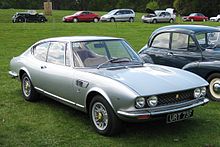Fiat Dino
| Fiat Dino | |
|---|---|

1968 Fiat Dino Coupé
|
|

1970 Fiat Dino 2400 Spider
|
|
| Overview | |
| Manufacturer | Fiat |
| Production | 1966–1973 |
| Assembly |
Rivalta, Turin (1966–69) Maranello, Modena (1969–73) |
| Designer |
Pininfarina (Spider) Giorgetto Giugiaro at Bertone (Coupé) |
| Body and chassis | |
| Class | Sports car |
| Body style | 2-door coupé 2-door spider |
| Layout | Front-engine, rear-wheel-drive |
| Related | Dino 206 GT and 246 GT |
| Powertrain | |
| Engine | 2.0 L Dino V6 (1966–69) 2.4 L Dino V6 (1969–73) |
| Transmission | 5-speed manual |
| Dimensions | |
| Wheelbase | Coupé: 2,550 mm (100.4 in) Spider: 2,280 mm (89.8 in) |
| Length | Coupé: 4,507 mm (177.4 in) Spider: 4,109–4,237 mm (161.8–166.8 in) |
| Width | Coupé: 1,696 mm (66.8 in) Spider: 1,709 mm (67.3 in) |
| Height | Coupé: 1,287–1,315 mm (50.7–51.8 in) Spider: 1,245–1,270 mm (49.0–50.0 in) |
| Kerb weight | Coupé: 1,270–1,380 kg (2,800–3,042 lb) Spider: 1,150–1,240 kg (2,535–2,734 lb) |
The Fiat Dino (Type 135) is a front-engine, rear-wheel-drive sports car produced by Fiat between 1966 and 1973. The Dino name refers to the Ferrari Dino V6 engine, produced by Fiat and installed on the cars to achieve the production numbers sufficient for Ferrari to homologate the engine for Formula 2 racing.
The Dino road cars came to be because of Enzo Ferrari's need to homologate a V6 engine for Formula 2 racing cars. In 1965 the Commission Sportive Internationale de la FIA had drawn up new rules, to be enacted for the 1967 season. F2 engines were required to have no more than six cylinders, and to be derived from a production engine, from a road car homologated in the GT class and produced in at least 500 examples within 12 months. Since a small manufacturer like Ferrari did not possess the production capacity to reach such quotas, an agreement was signed with Fiat and made public on 1 March 1965: Fiat would produce the 500 engines needed for the homologation, to be installed in a GT car which remained to be specified.
Dino was the nickname of Enzo's son Alfredo Ferrari, who had died in 1956 and was credited with the concept for Ferrari's Formula 2 V6 racing engine, believed to be designed by Vittorio Jano with a peculiar 65° angle between the cylinder bank. In his memory, V6-engined Ferrari sports prototype racing cars had been named Dino since the late 1950s. The conversion of this racing engine for road use and series production was entrusted to the engineer Aurelio Lampredi, who had previously designed several 4-cylinder Ferrari engines. Interviewed in the early 1980s, Lampredi noted that "things didn't work out exactly as Ferrari had foreseen": Enzo Ferrari had counted on building the engines at Maranello, but Fiat's management insisted on taking control of production, to avoid any breaks in the engine supply. The resulting Fiat-built V6 ended up being installed in two very different vehicles: the Fiat Dino, a front-engined grand tourer assembled in Turin by Fiat, and in Ferrari's first series-produced mid-engined sports car, built in Maranello and sold under the newly created Dino marque. Even on the cylinder block casting, the name FIAT was visible which was not in line with the newly created DINO make.
...
Wikipedia
